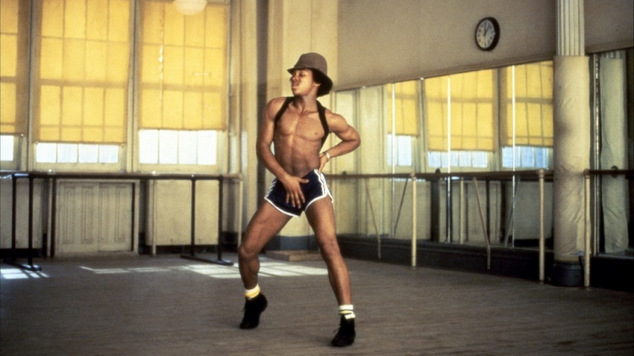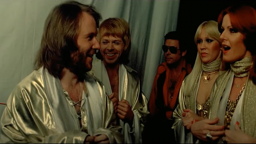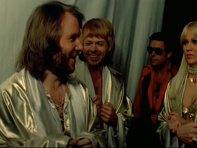First impressions are everything in show business, and Gene Anthony Ray knew how to make an unforgettable one. In his introductory scene as Leroy Johnson, a street-smart, rebellious dance prodigy in Fame, Alan Parker’s gritty Oscar-winning 1980 musical about students at a performing arts school, Ray effortlessly stole the focus from a female friend he was helping audition. Clad in barely-there satin shorts and a sleeveless shirt pulled behind his head to accentuate his flawless torso, Ray electrified audiences with his sultry dancing.
“What do you call that?” a teacher asks the instructor, played by Debbie Allen, as they take in Leroy’s suggestive moves. Allen, no slouch on the dance floor herself, instinctively replied, “Wicked!”
Viewers couldn’t help but agree.
The time was right for Gene Anthony Ray to take the spotlight
It was the spring of 1980 when Fame was released to movie theaters. Disco was dead. MTV was yet to be born. Off The Wall, Michael Jackson’s smash R&B album still ruled the music charts. A series of films, such as Saturday Night Fever, Grease, and All That Jazz, which showcased dazzling dance numbers, had been surprise hits at the box office. Audiences were now ready for something to fuse the edgier and slick elements.
They wanted someone with some mean street strut in his step. Seventeen-year-old Ray filled the bill with ease.
Although Ray would often maintain that he wasn’t a real-life Leroy, both used their incredible charisma and raw talent and innate dancing ability to escape from a troubled family life in Harlem. Ray honed his fancy footwork at neighborhood block parties. He claimed to win every contest he entered as a kid and every competition he could find — even winning the award as the best male disco dancer at New York’s famed Roseland Ballroom.
As a young teen, Ray had even attended the real-life performing arts school depicted in the film, although he was expelled during his first year. In a 2003 cast reunion interview, he confessed he was kicked out due to his mouth and bad attitude toward authority figures.
In the same interview, Allen, who’d developed an almost familial relationship with Ray while making the movie, described him as “an amazing ball of energy and fire who was sweet and sour at the same time.” She also claimed Ray had slapped one of his teachers at the school. Still, rebelliousness often translates well to the screen. Ray’s made him a relatable character to legions of impressionable young people.
Dancing his way through Fame and sexuality

Along with Allen and two other actors from the film, Ray was asked to reprise his character in the television series in 1982. Although it struggled for ratings in the U.S., the small-screen version of Fame became a bona-fide phenomenon in Europe. It was produced for six seasons, and the cast performed in concerts to adoring, screaming crowds.
Ray not only emerged as the sex symbol of Fame, but his face became synonymous with the series. His appeal was so strong that he was forced to hire two secretaries to handle the voluminous fan mail he received — reportedly 17,000 letters each day at one point. With his sad eyes, photogenic features, and chiseled, Adonis-like physique, Ray was naturally a popular subject in fan magazines read predominantly by females. Still, he always deflected questions about his sexual orientation.
The 1980s, when the AIDS pandemic was written about in terms befitting a horror movie, was a more challenging time to be out to the general public, of course. It was a veritable career suicide. Among friends, though, Ray was completely open about his sexuality.
During interviews conducted at this time, Ray seemed guarded about some aspects of his private life and often butched it up in front of the camera. Later, his flair for camp became more apparent, his gestures became more flamboyant, and he rolled his eyes more frequently. He seemed to always be looking for a quick joke to deflate tension.
During the height of his career, when questioned about his love life, Ray always maintained that due to his exhausting work schedule, he only had time for one woman — his mom, Jean.
Gene Anthony Ray’s leading ladies
His mother would indeed play a significant role in both his personal life and career. In 1983, a house he bought for his family in a mostly Caucasian neighborhood in New York was subjected to four separate arson attacks, believed to be racially motivated. Thankfully, no one was harmed during these fires.
In that same tumultuous year, Jean, along with her mother, found themselves entangled in a major drug sting operation, facing charges related to the sale of cocaine and heroin. Despite the public humiliation and personal turmoil, Ray displayed unwavering loyalty by attending Jean’s court hearings, standing by her side through the legal proceedings, even as she received a 15-year prison sentence.
Another female he became close to was Marguerite Derricks, a beguiling, energetic blonde who joined Fame as a dance student during its second season. She and Ray were fast friends, and, as she recalls, he immediately defended her against petty jealousy when she was first cast in the series.
“The dancers were rather bitchy when I first joined because it was very much like a real high school and I was the new kid,” Derricks, now an award-winning choreographer for films such as Showgirls and the 2009 remake of Fame, told Queerty.
“They were whispering behind my back, ‘We don’t need her.’ Gene Anthony walked in the room and immediately saw what was going on and put his arm around me. He said, ‘Y’all are just some tired bitches!’ We became really great friends. I later became friends with all the dancers, but he was always my protector. He was louder than anyone could be, but he had the biggest heart in the world. He was really wonderful.”
Marguerite Derricks on Gene Anthony Ray helping her during her first season of Fame
Derricks also admired the close relationship Ray had established with Debbie Allen.
“He and Debbie would get on the dance floor and it was magical,” she shares. “Their relationship was magical. They loved each other very much. She took care of him like a big sister and loved him and protected him. He really looked up to her.”
In an interview conducted after his death, Allen recalled Ray’s mischievous, sometimes temperamental nature when he grabbed her ass while she was singing. Allen scolded him, and Ray was so hurt that he destroyed a dressing room.
The cost of success was hard for Gene Anthony Ray to take

Ray could dance lighter than air. Fame choreographer Louis Falco compared Ray to a young Fred Astaire, and could kick higher than most female dancers. He could also out-party the rest of his cast members and friends.
Popularity comes at a cost, particularly when you’re young and making money beyond your wildest dreams. Although he appeared in all six seasons of Fame, Ray’s drinking and drug use escalated, and he was eventually suspended for a time after missing nearly 100 days of shooting.
Derricks makes it clear that Ray was 100 percent present and hard-working when he was on set.
“When he walked into a room not only would the light shine but the room would shake,” she recalls. “I’ve never met someone who was so charismatic. It was just natural. Everyone wanted to be around him. He was funnier than anybody. He’d make up raps sometimes to songs….He was a natural dancer. He was naturally great at everything. I trained really hard to do what I do. For Gene, he could just look at something and do it better than anybody else.”
Life after Fame
Following the cancellation of the series in 1987, Ray’s professional life became a long series of failed opportunities. An appearance in a Weather Girls music video led to little.
He landed a role in the highly-anticipated musical adaptation of Carrie in London. He received respectful reviews in the part played by John Travolta in the 1976 film.
Unfortunately, the show became infamous as one of theater’s most notorious short-lived flops. He even performed on cruise ships. Substantial employment proved elusive to Ray.
During this period, it becomes challenging to sort out the factual details of Ray’s life. He headlined a show at Glam Slam, a Los Angeles nightclub owned by Prince. He embarked on a European dance tour and unsuccessfully tried to launch a Fame-style dance company in Milan, Italy. His partying continued unabated, though, and he blew through his savings. There, he was arrested for stealing a bottle of wine from a supermarket to attack a couple of men harassing him, although the charges were dropped. He reportedly also slept on a park bench sometimes.
Friends who knew Ray when he lived in Los Angeles in the early ’90s but who asked to remain anonymous for this article shared wildly different opinions of him. One man who knew him from West Hollywood bars remembered he was friendly and always offered a smile but was rarely sober. Another man who knew Ray intimately noted that he would get arrogant when drunk or using drugs, and it was a primarily unpleasant time when the two men were acquainted. As Debbie Allen said, Ray was a mixture of sweet and sour at the same time.
The HIV diagnosis

In 1993, the British press ran a series of sensational newspaper headlines saying that Ray was dying of AIDS, even though he didn’t test positive for HIV until later. Ray said he was apprehensive about denying the stories out of respect for his suffering from HIV/AIDS. When he did test positive in 1996, Derricks was the first person Ray called.
“We were on the phone for hours, just crying,” she recalls. However, the next day, he rang her again to tell her the diagnosis was a mistake. Unsure of the exact reason, Derricks stops short of speculating that Ray didn’t want to become an emotional burden.
“We had seen so many of our friends from that time die,” she adds. “It was a really, really difficult time. It felt like every other week we were going to the hospital to visit our friends.”
A camera crew from entertainment channel E! caught up with Ray in Italy in 2002 as he posted flyers for a male stripper review he was headlining under the stage name “Leroy Johnson.” It’s a very unsettling interview. He appeared gaunt, unfocused, and almost unrecognizable, claiming someone had just punched him in the face.
In another on-camera interview conducted the following year, Ray looked healthier and more robust and noted the fickleness of fame. “Just as quick as you had it, it can go, and it’s much more harmful than never having had it before.”
Interviewed for supplemental materials for Fame’s DVD release in 2002, Ray acknowledged his influence on a generation of musical theater performers. “If your work, what you’ve done has inspired somebody to do well and do something positive in this crazy world today, it’s worth it,” he stated. “I’ll do it again.”
Sadly, he’d be dead within a year at age 41.
Gene Anthony Ray’s friends remember the icon
Like many of Ray’s friends, Derricks was surprised when he died following what was reported as complications from a stroke. She reveals that Ray occasionally became quite ill, but he seemed to always recuperate. “He was in a hospice and was really, really sick and I went to visit him every day and then he was fine,” she remembers. “He always bounced back.”
Allen was also shocked at Ray’s young demise. She wiped away tears as she remembered a phone call from his mother, who’d been released from prison in 1999, telling her this was her last opportunity to speak to her friend, that he probably wouldn’t live through the night. She’d soon find herself rushing to New York to attend his funeral in November 2003.
Although Ray never found another project that showcased his talents the way Fame did, it’s easy to see his influence in series such as Glee and a generation of musical performers who followed him. To borrow a lyric from the movie’s Oscar-winning theme song, “As long as cinema endures, we’ll continue to remember his name.”
To learn more about Ray and Fame, go here.
Let Gene Anthony Ray blow your mind with his dancing below:
Related*


Campy or not? Director Jeffrey McHale on the “spiritual experience” of ‘Showgirls’
We chat about why the film endures and why so many of us love it in all its godawful glory.


From ‘Fellow Travelers’ to ‘Elite’: 15 queer TV shows we’re most excited about this fall
There are new shows, returning favorites, and way more seasons of ‘Drag Race’ headed your way this fall.


We’ve all seen ‘Mamma Mia!,’ but ABBA’s campy 1977 tour movie is a must-watch for true fans
‘ABBA: The Movie’ is a fascinating look at life at the height of ABBA-mania.
Subscribe to the Queerty newsletter and stay in step with the latest stories, celebrating the extraordinary journeys that continue to shape the world of entertainment and culture!


















































JerseyMike
Its a shame people were still dying from AIDS in 2002.. meds were so much better than the 80 and early 90s.. people are still dying from AIDS today.. I think my cousin passed from it. Only 26 yrs old.. think more about shame and ignorance of programs out there now..
da90027
I used to see him at a club I worked at in the early 90s and it was sad he was always drunk or high…such a waste of talent
Xzamilio
I just remember the first time seeing this movie and falling in love with Leroy. Just a great movie and great person
Ronbo
He inspired so many and was lost far too soon. He is the definition of “fierce”.
Tim Collins
Break me off some of that
money718
He had fantastic legs.
Gigi Gee
@da90027: Like many of us, he was dealing with a lot of demons. And he was famous. Sometimes it’s a lethal combination.
Bob LaBlah
I remember seeing the movie Fame back in 1980 and got so jealous of my friends who came to Hollywood to act. I left that theatre feeling pretty low but the movie was GOOD. I actually saw it twice. It was at that theatre on Sunset Blvd right across the street from the old Merv Griffin studio at Vine.
I do hope some one can remember the name of a black restaurant that was right above Hollywood Blvd back in the 1980’s and was a good spot to see black celebrities. It was The Southern some-thing-or-other, I honestly can’t remember the name. Anyway, I saw him there twice. He seemed to be a nice guy to me but if he was not interested he did not look nor return your polite greetings. Considering how nearly all of us back then were into…..well, we were into what we were into. Too bad he let it get the best of him.
Another interesting figure from that era was little Michael on Good Times (Ralph Carter). He has publicly stated that he has AIDS and has been hospitalized numerous times and in a hospice twice. The tabloids had him on his death bed about ten years or so ago but he has since come back. Damn, I am getting old. But thanks anyway for reminding me, Queerty.
silveroracle
A truly talented man.
BeachDaddyDave
Oh, how I adored him. He seemed to have it all—and he did, for a while. Talent, looks, charisma. Rest in Peace–you are not forgotten.
Yiannis
Possibly the best article that I’ve read in Queerty for quite some time. Thanks Jeremy!
Kangol
He was a wonderful talent, so handsome and such a force both in the movie and the TV show. I remember how sad it was to learn that he was sick and then that he was struggling to stay healthy and afloat at the end of his life. I really appreciate that Queerty devoted an article of this length and care to Gene Anthony Ray.
alphacentauri
rest in peace.
Chris
I remember his dancing; it was awesome.
And Queerty, congrats. You finally produced an honest and readable article that highlights a gay man without resorting to innuendo or to cheap sensationalism. Keep up the good work.
Franklin
I feel like it’s been a rumor that Ralph Carter is HIV positive and never confirmed. Anyhow, Gene Anthony Ray was one of the first gay black men I ever saw in movies as a little boy, the first gay black characters being the lesbian couple on “The Women of Brewster Place”. I have always been drawn to that movie and the TV show because of him. I heard that he had no formal dance training when he auditioned for the movie, just raw talent. It so sad that his life was taken at such a relatively young age. RIP
Hun
Nice body. Face is a little busted.
Bill Perdue
Too many deaths.
Realitycheck
I saw him at the boy bar in NYC when I was young, and the place was beyond crowd, Ray squeezed himself between my boyfriend and myself, pushing his
big ass right on the back of my hand, LOL I had totally forgot about that.
Realitycheck
@Bill Perdue: Yes Bill, most of my friends from my younger days are dead of HIV, I rarely think about it, so many years have gone by, but when I do it is overwhelming.
Nobody should have to die because they had sex.
Jeremy Kinser
@Bob LaBlah:
I searched through a few sites devoted to long-gone L.A. restaurants but couldn’t find the name of the one you reference.
As for Ralph Carter, I can’t find solid evidence that he revealed he has AIDS or is HIV-positive. There were some gossipy items on blogs, but the sources can’t be verified. If you see something I didn’t, let me know.
Bob LaBlah
@Jeremy Kinser………..I am not surprised that you could not find the restaurant in the long-gone era listings because it was not unusual for black owned restaurants and bars to be excluded from the listings of anything related to Hollywood. It wasnt until around 1985 or so that Catch One was listed in the Gay Guide books of the era. ‘t was NOT a gay restaurant by the way. It was right above Hollywood Blvd on Cahuenga blvd, I do believe. It moved to a location right off of Sunset Blvd and closed less than two years later. I want to say it was called the Southern Kitchen, but can’t be sure. But I do know it was The Southern something….Now you have me on a quest to find the name of that restaurant. It did exist, trust me. It was very popular but don’t forget these are the 1980’s we are talking about. The majority of todays young folks have no idea (nor money to eat out with) of many things regarding old Hollywood. I had no idea the Yukon Mining Company closed as long ago as it did either. That was another cool place to eat (breakfast only for me because they served homemade biscuits).
As for the black restaurant Latoya Jackson’s untalented ass was a regular as were people from yesteryears day of Motown, which was only a few blocks away down on Sunset blvd. You drank beverages from Mason jars. That is what helped give it its flavor. The patrons were WELL integrated with the majority of the white patrons from the south who appreciated a place where the cook knew how to make collard greens (yes, we white folks from the south DO eat them too) that tasted like back home….er, um forgive me. That REMINDED me of back home is what I meant to say.
Now, as for Mr. Carter, it was reported in the tabloids back in the 1990’s that he was in a hospice several times. Who ever this “friend” was that was being quoted said that it (the hospice) was located in Brooklyn, NY. It was either the National Enquirer or the other one. I had no reason to doubt the story because after Carol Burnett successfully sued their asses back in the 80’s they got ACCURATE with their stories before they went to print. As in two or three VERIFIABLE sources, depending on who it was. I am not knocking that kid at all and am glad to see that he did have a sex life, as we all should. It pains me now to do a Google search and see pictures of his face and how drawn in it appears. I know one shouldn’t come to conclusions from a picture but looking at him and remembering how many people I lost to that damned disease for me, it adds up I am sorry to say. I would still hug him because I grew up with him as far as I am concerned. It would not shock me at all to learn he did the same thing Gene Anthony Ray is accused of, denying the truth regardless of who knows it. After all, it is HIS life and HIS business regardless of his being an actor.
I appreciate your offer to send you verification if found and will act upon it. Unfortunately, the National Enquirer nor Globe allow reprints of their stories. I have sent numerous stories in the past (I quit back in April of this year) to Queerty that used to get at least a “thank you” response from you guys. When that stopped along with the stories not being printed (and yes, they were ALL related to gay topics) I assumed that I had been placed on the junk mail block list or was simply ignored completely do to overwhelming tasks that you guys have to do throughout each day.
I close with this; I am reasonable enough to take into consideration how many emails ( and flags from dummies who will flag ANYTHING people say that rub them the wrong way in the comment section) you receive each day but being polite goes a long way to people watching out for your retention of readers and simply ran across something interesting to share. I love your site and think you guys do a damn good job, especially considering how no paid advertising is present. Keep up the good work.
CWM85
One of the better articles on here. I sure wish queerty would devote more content to truly meaningful people and stories. Gay culture is more than hard bodies, speedos, porn stars, straight male fantasies etc. This was well written and touching.
BeachDaddyDave
@Yiannis: Yes. I would love to see more substantive articles like this. Queerty could do a lot more to connect our community to its history than just stories about models and big dicks.
Jeremy Kinser
@BeachDaddyDave:
Based on reader response, there’s an audience for all types of articles on Queerty. Several of you have suggested you’d like to read more in-depth articles like this. It was fun to research and write this one so please feel free to suggest subjects or cultural figures you’re interested in learning more about.
Sansacro
Great to see this. Was obsessed with the film as a kid actor living in NYC, Recall running out and purchasing the album and playing it for months. Only a few years younger than stars in the movie. Will definitely “remember their names.” 😉 Times Square a gritty and culturally rich place back then. Loved it.
Bob LaBlah
@Jeremy Kinser: I accept your offer and strongly suggest this pioneer as someone who has been largely ignored by the community that he himself was not only part of but went out of his way to protect. I sent this article to damn near every gay online publication out there at the time (and even sent it to you guys several years in June around Pride parade time) and got ignored by ALL. No one thought what he did was important but I disagree. Hopefully you will reconsider.
http://www.latimes.com/nation/la-me-joel-weisman23-2009jul23-story.html
Tobi
A lifetime ago, Gene Anthony Ray asked me for a dance at the Embassy Club in Bond Street. I have a sneaking suspicion it was only to escape Stephen Hayter and Lady Edith Foxwell who were both fighting over him like two dogs after the same bone. But still… !